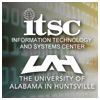LEAD2
Scientific advances and societal benefits associated with the accurate prediction of mesoscale weather are enormous. However, presently available computational and data management frameworks are unable to accommodate the real time, on-demand, and dynamically-adaptive nature of mesoscale problems; the complexities associated with its vastly disparate, high volume and bandwidth data; and the tremendous computational demands of its models and data assimilation systems.
The University of Alabama in Huntsville's Information Technology and Systems Center (ITSC) joined seven other universities to overcome these limitations. This joint IT research enabled an integrated, scalable framework -- known as Linked Environments for Atmospheric Discovery (LEAD) -- for use in accessing, preparing, assimilating, predicting, managing, mining/analyzing, and displaying a broad array of meteorological and related information, independent of format and physical location.
The LEAD concept involves a series of interconnected IT "environments" that provide a complete framework within which users can identify, obtain, and work with observational, computer model, and user-generated information - and do so in a distributed setting where real time data streams and decision making are important, and where both the problem being addressed and the computational resources can change dynamically with time. The IT research established the LEAD Portal that served as the user's primary window to the LEAD world. The Portal provides linkages to the User Productivity Environment, which contains a broad array of tools, models, and algorithms for operating on and visualizing data and other information made available within the Data Cloud.




